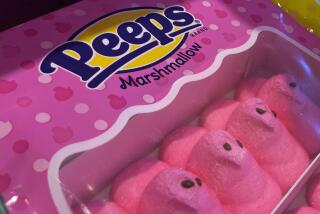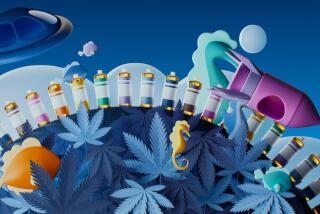Baking Soda’s Star Rises : Out of the Fridge, Into . . . Everything
By the industry’s own score card, boxes of baking soda are sucking up odors inside nearly nine out of 10 American refrigerators. More refrigerators are likely to have baking soda than working light bulbs.
But thanks to clever marketing--and consumer perception that baking soda is a veritable magic potion--baking soda is now coming out of the fridge.
These days, it’s in the medicine cabinet (in some brands of toothpaste, mouthwash, dental floss, shampoo, deodorant, foot powder, feminine napkins, douches and, yes, even a sore throat gargle); the broom closet (carpet deodorizer, laundry detergent, air freshener) and, of course, the kitty litter box.
What’s next? Well, one company is testing a baking soda makeup remover--just in case you want to bubble your rouge away.
“Baking soda is becoming the oat bran of the 1990s,” said Lynn Dornblaser, publisher of New Product News, a Chicago trade publication. And like many of the oddball things that oat bran was mixed into during its heyday in the 1980s, she said, “baking soda is starting down the road toward goofiness.”
But few consumers seem to think it’s goofy. Baking soda will be promoted as a key ingredient in 25% of the estimated $1.5 billion worth of toothpaste sold this year. What is it about baking soda as an ingredient that prods consumers to grab it off the shelf?
“It has an aura of being natural--whatever that means,” said Jerald Jellison, USC professor of psychiatry. “And a ring of purity.”
But it also has chemical elements that truly work. When baking soda is mixed into cake batter, it releases a carbon dioxide gas that causes the mixture to rise. For deodorizing, it kills odors by chemically neutralizing most odor molecules it comes into contact with. And as a cleaning agent, it gets out dirt by neutralizing fatty acids found in most dirt and grease.
“A lot of people grew up with that yellow box in their refrigerators,” said Al Heller, editor in chief of the New York trade magazine Non-Foods Merchandising. “There’s a nostalgia factor there. And people trust the ingredients.”
They trust it so much, in fact, that baking soda--also known as sodium bicarbonate--was one of the primary ingredients used to clean the Statue of Liberty before the Bicentennial celebration in 1976.
And to think that at one time this powdery, white mineral deposit was relegated to making bread rise.
Truth is, there’s nothing really new about baking soda. What’s new is the array of products the stuff is being stirred into, said Clive Chajet, chairman of the New York corporate image firm Lippincott & Margulies.
“It was always under-marketed,” Chajet said, “and at the end of the day, marketers have got to have something new to talk about. So why not baking soda?”
It would be hard to find a company that knows more about baking soda than Church & Dwight, which makes the 148-year-old Arm & Hammer brand. Its familiar logo--a muscular arm holding a steel hammer--ranks among the world’s most recognized product symbols.
But the company was generally satisfied to let baking soda just be baking soda until the mid-1980s. That’s when its marketing department began to push the company to start taking tips from consumers--who suggested they make a baking soda-based laundry detergent. This was soon followed by a carpet deodorizer and a room freshener.
*
At about the same time, the company started adding it to toothpaste. Since then almost every toothpaste maker--from Crest to Colgate--has followed suit. And last year Chesebrough-Pond’s introduced Mentadent toothpaste--which it has successfully marketed on the basis of two key ingredients: peroxide and baking soda.
But besides tingling in the mouth, does baking soda actually clean teeth any better? Some dentists believe that the bubbling action of baking soda in the mouth can result in deeper cleaning of the teeth and gums. But one expert firmly disagrees.
“For oral hygiene, it does nothing of any great significance,” said Dr. Nathaniel Rowe, chairman of the Council on Dental Therapeutics, which is the division of the American Dental Assn. in charge of accrediting various toothpastes. “It doesn’t do much because it dissolves so quickly in saliva. There’s really nothing you can hang your hat on.”
In fact, the council’s main concern in testing toothpastes with baking soda, he said, is to make sure that baking soda’s chemicals don’t counteract the good things that fluoride does.
But executives at Church & Dwight--while making no specific claims about what baking soda can do for teeth--say the sales figures speak for themselves.
“Do you think we could con one quarter of the population if they were not actually getting some sort of benefit from it?” asked James E. Barch, vice president of marketing at Church & Dwight.
Meanwhile, Arm & Hammer has reached well beyond toothpaste. Just a month ago it introduced an antiperspirant deodorant with baking soda. The company hopes it sells better than the baking soda oven cleaner it sold briefly in the 1970s before taking it off the market. “The consumer had a tough time accepting baking soda in such a down-and-dirty category,” Barch said.
That isn’t stopping others from trying even more rather oddball uses for the product.
Earlier this year, the folks who make Odor Eaters began to put it into their foot powder. “Consumers are aware of its odor-destroying properties,” said Rick Kornhauser, marketing director at Combe Inc. “It’s a perfect fit with foot care.”
Two months ago, baking soda began to show up in a shampoo made by Western Pleasure Inc. of Omaha, Neb.
“In a liquid state, baking soda effervesces and cleans deeper than normal shampoo,” said Bill Frye, president of the company that, until now, sold the brand only in hair salons. “A lot of models, surfers and ranchers use it,” he said.
Among the most unusual baking soda products, scheduled to hit store shelves in September, is a medication that is supposed to relieve a sore throat: GargleAid.
Baking soda helps draw fluids from the throat, said Diane Davis, director of marketing at Tech Laboratories Inc., the Albany, Ore., maker of GargleAid. “It works a lot better than your Mom telling you to gargle with salt water.”
Soda, Soda Everywhere Baking soda was first sold in 1846 as a cleaning agent. But consumers and marketers have since found many uses for the product. The most common are ... * In the refrigerator to neutralize food odors.
A chemical reaction occurs when odors wafting through the fridge encounter baking soda. Some of the baking soda becomes a sodium salt, giving off water and carbon dioxide that neutralizes other odors.
* In baking to make food rise.
As the oven heats up, the baking soda decomposes to release quantities of carbon dioxide gas. This produces tiny bubbles throughout the dough and makes the baked product rise. But consumers and industrial companies have found some unusual uses. Here are ten. * In feed to boost the fertility of goats. * In fire extinguishers to kill cut off the oxygen supply of the blaze. * In factory exhaust smoke stacks to help reduce air pollution. * In sewage treatment plants for odor control and to break down waste products.
* Medicinally to soothe bee stings and rashes. * As an effervescent ingredient in some bath powders * To kill the odor in the cat litter box. * As a caustic agent for big cleaning jobs. (It Was used to clean the Statue of Liberty in 1986) * To neutralize automobile battery acid to facilitate cleaning. * As an environmentally friendly substitute for noxious paint solvents in stripping.
With such a myriad of uses, baking soda is among the top selling consumer products. Between April and the end of June this year, consumers bought 26 million pounds. That compares to 25.2 million pounds in the same period last year and 24.1 million in the 1992 period.
Sources: Church & Dwight; James E. Brady & Gerard E. Humiston, General Chemistry 4th Edition; Information Resources Inc.
Researched by ADAM S. BAUMAN
More to Read
Eat your way across L.A.
Get our weekly Tasting Notes newsletter for reviews, news and more.
You may occasionally receive promotional content from the Los Angeles Times.









